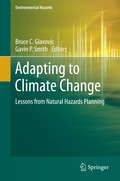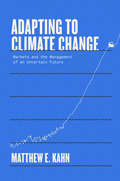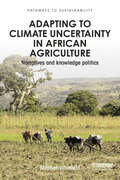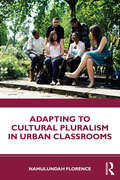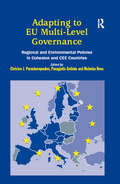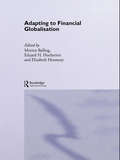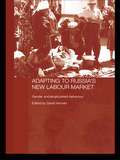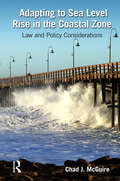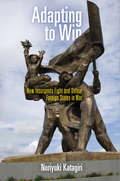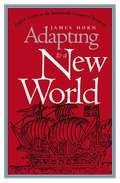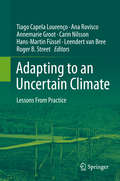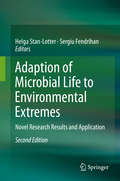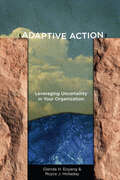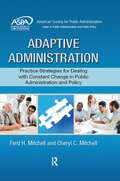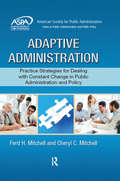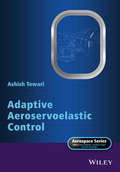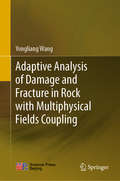- Table View
- List View
Adapting to Climate Change: Lessons from Natural Hazards Planning (Environmental Hazards)
by Bruce C. Glavovic Gavin P. SmithThis book identifies lessons learned from natural hazard experiences to help communities plan for and adapt to climate change. Written by leading experts, the case studies examine diverse experiences, from severe storms to sea-level related hazards, droughts, heat waves, wildfires, floods, earthquakes and tsunami, in North America, Europe, Australasia, Asia, Africa and Small Island Developing States. The lessons are grouped according to four imperatives: (i) Develop collaborative governance networks; (ii) build adaptive capabilities; (iii) invest in pre-event planning; and (iv) the moral imperative to undertake adaptive actions that advance resilience and sustainability. "A theoretically rich and empirically grounded analysis of the interface between disaster risk management and climate change adaptation, comprehensive yet accessible, and very timely. " Mark Pelling, Department of Geography, King's College London, UK. "This book represents a major contribution to the understanding of natural hazards planning as an urgent first step for reducing disaster risk and adapting to climate change to ensure sustainable and equitable development. " Sálvano Briceño, Vice-Chair, Science Committee, Integrated Research on Disaster Risk IRDR, an ICSU/ISSC/ISDR programme. Former Director International Strategy for Disaster Reduction, UNISDR. "What a welcome addition to the young literature on climate adaptation and hazard mitigation! Bruc e Glavovic and Gavin Smith each bring to the editing task a rare blend of solid scholarly attainment and on-the-ground experience that shines through in this extensively-documented synthesis of theoretical ideas from the realms of climate and hazards and their validation in a rich set of diverse case studies pulled in from around the world. This book should remain a classic for many years. " William H. Hooke, American Meteorological Society.
Adapting to Climate Change: Markets and the Management of an Uncertain Future
by Matthew E. KahnA revelatory study of how climate change will affect individual economic decisions, and the broad impact of those choicesSelected by Publishers Weekly as one of its Top Ten books in Business and Economics for Spring 2021 It is all but certain that the next century will be hotter than any we&’ve experienced before. Even if we get serious about fighting climate change, it&’s clear that we will need to adapt to the changes already underway in our environment. This book considers how individual economic choices in response to climate change will transform the larger economy. Using the tools of microeconomics, Matthew E. Kahn explores how decisions about where we live, how our food is grown, and where new business ventures choose to locate are impacted by climate change. Kahn suggests new ways that big data can be deployed to ease energy or water shortages to aid agricultural operations and proposes informed policy changes related to public infrastructure, disaster relief, and real estate to nudge land use, transportation options, and business development in the right direction.
Adapting to Climate Uncertainty in African Agriculture: Narratives and knowledge politics (Pathways to Sustainability)
by Stephen WhitfieldFuture climatic and agro-ecological changes in Africa are uncertain and associated with high degrees of spatial and temporal variability and this change is differently simulated within divergent climate-crop models and in controlled crop breeding stations. Furthermore, uncertainty emerges in local contexts, not just in response to climatic systems, but to social, economic, and political systems, and often with implications for the appropriateness and adoption of technologies or the success of alternative cropping systems. This book examines the challenges of adaptation in smallholder farming in Africa, analysing the social, economic, political and climatic uncertainties that impact on agriculture in the region and the range of solutions proposed. Drawing on case studies of genetically modified crops, conservation agriculture, and other 'climate smart' solutions in eastern and southern Africa, the book identifies how uncertainties are framed 'from above' as well experienced 'from below', by farmers themselves. It provides a compelling insight into why ideas about adaptation emerge, from whom, and with what implications. This book offers a unique perspective and will be highly relevant to students of climate change adaptation, food security and poverty alleviation, as well as policy-makers and field practitioners in international development and agronomy.
Adapting to Cultural Pluralism in Urban Classrooms
by Namulundah FlorenceThis book helps teachers explore the origins of differing value structures in safe forums. It uses guided cross-cultural exchanges to help break down prejudices and foster an appreciation of other cultures and the essence of a common humanity. Acknowledging the inextricable link between cultural and structural factors in the plight of vulnerable student populations, this work focuses on how to help counter prevailing disparities in perceptions and expectations within school settings. Designed primarily for teacher candidates, this book offers educators a forum for recognizing the impact of primary backgrounds in teaching and learning. Adapting to Cultural Pluralism in Urban Classrooms focuses on four elements in the teaching/learning process: school climate; the views and expectations of teachers in solidarity with principals and policy makers; teacher interactions with students and parents; and the centrality of reflection to improve practice. It offers tools to support cultural adaptations that enhance the academic success of inner-city students served by predominantly white and more privileged teachers.
Adapting to EU Multi-Level Governance: Regional and Environmental Policies in Cohesion and CEE Countries
by Nicholas Rees Panagiotis Getimis Christos ParaskevopoulosThe main theme of this book is the adaptation process of the new EU member states from Central-Eastern Europe (Hungary and Poland) to the multi-level system of governance in public policy, particularly in the regional and environmental policy areas. The work conceptualizes policy learning and institutional and policy adaptation within the EU system of governance and draws lessons from the experience of previous waves of enlargement-cohesion-countries (Ireland, Portugal and Greece). In doing so, the book makes an important contribution to the literature on the transformation of domestic policy-making structures, as a result of the increasing Europeanization of public policy, as well as on the conceptual tools, explanatory variables and mechanisms determining this process.
Adapting to European Integration: Small States and the European Union
by Kenneth Hanf Ben SoetendorpAdapting to European Integration describes how the political institutions in eight small member states and two non-members responded to the internal and external demands springing from the process of European integration in general and EC/EU membership in particular. The study makes a distinction between governmental/administrative adaptation, political adaptation and strategic adaptation. The chapters focus, in the first instance, on the governmental/administrative responses at the level of central government, the organisational adjustments and the changes in institutional capacity to meet the new challenges. The authors also look at the willingness of the political decision-makers to internalise the EC/EU dimension in domestic policy making and the way in which the country's own history as well as the attitude towards European integration facilitate or hinder adaptation and change.
Adapting to Financial Globalisation (Routledge International Studies in Money and Banking #Vol. 14)
by Elizabeth Hennessy Morten Balling Eduard H. HochreiterAdapting to the demands of financial globalisation is currently one of the most pressing preoccupations of bankers, financial institutions and financial authorities. Many aspects of this issue are addressed in this volume, based on a colloquium held in Vienna in April 2000 by the Société Universitaire Européene de Rechèrches Financières (SUERF) jointly with the Austrian National Bank.Individual chapters, written by academics, central bankers and market professionals, focus on the strategic implications of global pressures which are tending to eradicate the previously clear boundaries of time, distance, legal frameworks, culture, languages and currencies.
Adapting to Online and Blended Learning in Higher Education: Supporting the Retention and Success of the Expanded and Diversified Intake
by David Kember Robert A. Ellis Si Fan Allison TrimbleHigher education has undergone a massive transformation in teaching and learning in a very short period of time since the onset of Covid-19. Students, teachers and universities have had to adopt online and blended learning, often with little or no experience or models of good practice to draw upon. It is clear that blended and online learning are here to stay. This book draws on research from universities that have adopted online and blended learning to facilitate the expansion and diversification of their intake; which resulted in considerable experience and expertise in online and blended teaching. The book describes a model, tested with qualitative and quantitative data, which shows how teachers can support the retention and success of online and blended learners with four high-quality pedagogical elements: bite-sized videos of interest and relevance; learning materials that are well organised and provide a clear learning roadmap; discussion forums which are set up and moderated so as to result in lively student-student and student-teacher interaction; and, online teachers being approachable and responsive to communication with individual students through email, phone and online communication platforms. This model is explained and profusely illustrated with examples from the teaching of award-winning teachers. This book introduces the concept of a spectrum from traditional to contemporary models of admission and course delivery in higher education. It explains how universities which have adopted a contemporary model, with high levels of blended and online learning, have been able to expand their intake and markedly diversify the student body. It discusses how to support the retention and success of online and blended learners. Student support services are examined from the perspectives of service providers and online and blended learners and the case is made for support services being aligned with student needs. The book has a discussion of university management systems which utilise feedback at all levels to improve alignment between support service provision and student needs.
Adapting to Russia's New Labour Market: Gender and Employment Behaviour (Routledge Contemporary Russia and Eastern Europe Series #Vol. 5)
by Sarah AshwinEconomic reform in post-Soviet Russia created not only a devastating decline in living standards, but also widespread insecurity and uncertainty. This book is the first to analyse the situation from a gendered perspective, shedding new light on the way in which Russians are coping with the transformation of the labour market. The book examines gender differences in responses to economic reform, and considers the implications of these for the labour market outcomes and wider well-being of men and women during transition. Based on original research carried out by an experienced team of sociologists, the book analyses the journeys of 240 men and women through the turbulent Russian labour market of 1999-2001. It includes chapters on: *the way gender norms inherited from the Soviet era have influenced responses to transition *sex segregation and discrimination in the labour market *gender differences in work orientations and behaviour *who benefits from networks *which life events are most likely to initiate downward economic trajectories.
Adapting to Sea Level Rise in the Coastal Zone: Law and Policy Considerations
by Chad J. McGuireFor as long as humans have been inhabiting coastal areas and recording what occurs in their environments, coastal zones have been defined through dynamic interactions. And this is further underlined by a more recent development: observed sea level rise. In a thorough but not overly technical approach, Adapting to Sea Level Rise in the Coastal Zone: Law and Policy Considerations provides a legal-policy framework for facing the challenges of sea level rise. The book includes an analysis of sea level rise adaptation strategies that examines the legal impacts of coastal land use decisions based on the current interpretation of private property rights in relation to public control over those rights. The author discusses the science behind sea level rise and highlights policy complexities and options. He then presents an overview of related legalities, and bringing it all together, applies the principles offered in the book, concluding with strategies and solutions and a perspective on the future. If we accept the premise that sea level rise is occurring and will continue for the foreseeable future, then we must begin to consider policy responses to this risk in coastal regions. Part of any pragmatic policy response must include a review of the options available to public institutions when developing and implementing rational adaptation policies. This book offers practical legal/policy approaches to sea level rise adaptation that promotes sound planning in the face of climate change and rising seas.
Adapting to Shorter Time Cycles in the United States Air Force: Proceedings Of A Workshop Series
by Division on Engineering and Physical Sciences Air Force Studies Board National Academies of Sciences, Engineering, and MedicineThe Air Force Studies Board of the National Academies of Sciences, Engineering, and Medicine hosted a three-part workshop series to investigate the changing paradigm of time and knowledge in modern-day warfare. Sponsored by the U.S. Department of Defense, three 2-day workshops were held virtually on September 16-17, 2020, September 23-24, 2020, and October 1-2, 2020. The objective of the first workshop was to explore the ways in which the U.S. Air Force (USAF) has adjusted its capabilities in response to past shifts in operational timing. In consideration of these past shifts, the second workshop aimed to consider when there could be an advantage to synchronize or desynchronize rates of change with adversaries. Participants had the opportunity to discuss lessons learned and possible changes for USAF Doctrine and future operations. The goal of the third workshop was to examine the implications to doctrine, concepts of operations, and command and control from the recent acceleration of battlespace operations, arising from wide-scale digitization, large-scale sensing, and faster technologies. In all three workshops, speakers explored the broader issues surrounding changing environments, and participants discussed ways to adapt to fundamental changes in the time constants of conflict. This proceedings is a factual summary of what occurred during the workshop series.
Adapting to Win: How Insurgents Fight and Defeat Foreign States in War
by Noriyuki KatagiriWhen insurgent groups challenge powerful states, defeat is not always inevitable. Increasingly, guerrilla forces have overcome enormous disadvantages and succeeded in extending the period of violent conflict, raising the costs of war, and occasionally winning. Noriyuki Katagiri investigates the circumstances and tactics that allow some insurgencies to succeed in wars against foreign governments while others fail.Adapting to Win examines almost 150 instances of violent insurgencies pitted against state powers, including in-depth case studies of the war in Afghanistan and the 2003 Iraq war. By applying sequencing theory, Katagiri provides insights into guerrilla operations ranging from Somalia to Benin and Indochina, demonstrating how some insurgents learn and change in response to shifting circumstances. Ultimately, his research shows that successful insurgent groups have evolved into mature armed forces, and then demonstrates what evolutionary paths are likely to be successful or unsuccessful for those organizations. Adapting to Win will interest scholars of international relations, security studies, and third world politics and contains implications for government officials, military officers, and strategic thinkers around the globe as they grapple with how to cope with tenacious and violent insurgent organizations.
Adapting to a Changing World--Challenges and Opportunities in Undergraduate Physics Education
by National Research Council Division on Engineering and Physical Sciences Board on Physics and Astronomy Committee on Undergraduate Physics Education Research and ImplementationAdapting to a Changing World was commissioned by the National Science Foundation to examine the present status of undergraduate physics education, including the state of physics education research, and, most importantly, to develop a series of recommendations for improving physics education that draws from the knowledge we have about learning and effective teaching. Our committee has endeavored to do so, with great interest and more than a little passion. The Committee on Undergraduate Physics Education Research and Implementation was established in 2010 by the Board on Physics and Astronomy of the National Research Council. This report summarizes the committee's response to its statement of task, which requires the committee to produce a report that identifies the goals and challenges facing undergraduate physics education and identifies how best practices for undergraduate physics education can be implemented on a widespread and sustained basis, assess the status of physics education research (PER) and discuss how PER can assist in accomplishing the goal of improving undergraduate physics education best practices and education policy.
Adapting to a New World
by James HornOften compared unfavorably with colonial New England, the early Chesapeake has been portrayed as irreligious, unstable, and violent. In this important new study, James Horn challenges this conventional view and looks across the Atlantic to assess the enduring influence of English attitudes, values, and behavior on the social and cultural evolution of the early Chesapeake. Using detailed local and regional studies to compare everyday life in English provincial society and the emergent societies of the Chesapeake Bay, Horn provides a richly textured picture of the immigrants' Old World backgrounds and their adjustment to life in America. Until the end of the seventeenth century, most settlers in Virginia and Maryland were born and raised in England, a factor of enormous consequence for social development in the two colonies. By stressing the vital social and cultural connections between England and the Chesapeake during this period, Horn places the development of early America in the context of a vibrant Anglophone transatlantic world and suggests a fundamental reinterpretation of New World society.
Adapting to an Uncertain Climate: Lessons From Practice
by Tiago Capela Lourenço Ana Rovisco Annemarie Groot Carin Nilsson Hans-Martin Füssel Leendert Bree Roger B. StreetClimate change highlights the challenges for long-term policy making in the face of persistent and irreducible levels of uncertainties. It calls for the development of flexible approaches, innovative governance and other elements that contribute to effective and adaptive decision-making. Exploring these new approaches is also a challenge for those involved in climate research and development of adaptation policy. The book provides a dozen real-life examples of adaptation decision making in the form of case studies: · Water supply management in Portugal, England and Wales and Hungary · Flooding, including flood risk in Ireland, coastal flooding and erosion in Southwest France, and flood management in Australia's Hutt River region · Transport and utilities, including the Austrian Federal railway system, public transit in Dresden, and Québec hydro-electric power · Report examining communication of large numbers of climate scenarios in Dutch climate adaptation workshops.
Adapting to the Land: A History of Agriculture in Colorado
by John F. FreemanAdapting to the Land examines the extent to which Colorado agriculturists adapted to or stretched beyond the limits of land and water. Historian John F. Freeman and horticultural scientist Mark E. Uchanski document the state’s agricultural history and provide context for the shift away from traditional forms of agriculture to the use of synthetic fertilizers, herbicides, and pesticides—and, most recently, to more values-driven practices to support the burgeoning popularity of natural and organic foods. This shift has resulted in the establishment of the global organic food processing and distribution industry, which has roots in Colorado. Ancestral Puebloans farmed and grazed within the limits of nature. Early settlers adjusted their cultivation methods through trial and error, while later agriculturists relied on research and technical advice from the Colorado Agricultural College. As part of wartime mobilization, the federal government prompted farmers to efficiently increase yields. To meet the demand for food and fiber scientific and technical innovations led to the development of new plant cultivars and livestock breeds, advances in mechanization, and widespread use of synthetic amendments. Increasing concern over soil fertility and the loss of irrigation water to urbanization contributed to more changes. Despite, or perhaps because of, what we see today along the Front Range, Colorado may still have a chance to slow or even reverse its seemingly unrestrained growth, creating a more vibrant, earth-friendly society in which agriculture plays an increasingly significant part. Scientific discoveries and innovations in regenerative cultivation are clearing the path to a more sustainable future. Adapting to the Land adds an ecological and horticultural perspective to historical interpretations of recurring agricultural issues in the state and tracks the concept of stewardship, suggesting that spiritual beliefs continue to contribute to debates over acceptable agricultural practices and the effects of urbanization upon the land. This book will be a key resource for students, scholars, and general readers interested in agricultural and Colorado history, sustainability, and rural sociology.
Adapting to the Stage: Theatre and the Work of Henry James
by Chris GreenwoodThis title was first published in 2000: The American novelist and playwright, Henry James, was drawn to the theatre and the shifting conventions of drama throughout his writing career. This study demonstrates that from the 1890s onwards James concentrated on adapting his novels and stories to and from the stage, and increasingly employed metaphors that spoke of novel-writing in terms of playwriting. Christopher Greenwood argues that these metaphors helped James to conceive himself as an artist who composed characters dramatically and visually, and in doing so sets his novels significantly apart from those of his contemporaries. In the introduction to the first part of the book, Greenwood examines James's career within the context of contemporary European and North American theatre, providing an appraisal of what James gained from contemporary theatre, his position in that milieu, and what he brought to it. Part 2 of the book focuses on two novels: "The Other House" and "The Spoils of Poynton", both of which illustrate the ways in which James used the mechanism of contemporary theatre to communicate a character's personality. Discussion of these two works is used to throw light on similar concerns that develop in James's later writing.
Adaption of Microbial Life to Environmental Extremes: Novel Research Results and Application
by Helga Stan-Lotter Sergiu FendrihanThis entirely updated second edition provides an overview on the biology, ecology and biodiversity of extremophiles. Unusual and less explored ecosystems inhabited by extremophiles such as marine hypersaline deeps, extreme cold, desert sands, and man-made clean rooms for spacecraft assembly are presented. An additional focus is put on the role of these highly specialized microorganism in applied research fields, ranging from biotechnology and nanotechnology to astrobiology. Examples such as novel psychrophilic enzymes, compounds from halophiles, and detection strategies for potential extraterrestrial life forms are discussed in detail. The book addresses researchers and advanced students in the fields of microbiology, microbial ecology and biotechnology.
Adaption-Innovation: In the Context of Diversity and Change
by M.J. KirtonAdaption-Innovation is a timely and comprehensive text written for anyone who wants to know more about dealing with problem solving, thinking style, creativity and team dynamics. In an age when teams have become critical to successful problem solving, Adaption-Innovation (A-I) theory is a model in this field, which aims to increase collaboration and reduce conflict within groups. A-I Theory and associated inventory (KAI) have been extensively researched and are increasingly used to assist teambuilding and personnel management. In the context of the management of diversity and change, Dr Kirton outlines the central concepts of the theory, including the processes of problem solving, decision making and creativity as well as explanatory concepts such as the paradox of structure; coping behaviour; the distinction between how teams collaborate on the common task and how teams manage their own diversity. In addition, Dr Kirton focuses on the positive side of managing a wide diversity within teams that has the potential to lead to the highest levels of problem solving, creativity and effective management of change. The book offers practical information for those helping diverse teams succeed in today's demanding climate. In this fresh context, leadership theory is explored, suggesting a new and interesting approach in use of different styles. For those working with diverse, problem solving teams managing complex change, this is a must have book. It will appeal to a broad range of people, from practitioners such as human resource managers, psychologists, business consultants, and group trainers, to academics studying and doing research in disciplines such as psychology, business, management, sociology, education and politics and the practical use of the hard sciences. *This reprint contains some new insights by Dr. Kirton into the theory. A small number of critical key changes have been made: a new diagram showing the difference between decision making and problem solving; some tightening of some sentences to show that leadership style should be treated as roles; the addition of the Glossary of Terms.
Adaptive Action: Leveraging Uncertainty in Your Organization
by Glenda H. Eoyang Royce J. HolladayRooted in the study of chaos and complexity, Adaptive Action introduces a simple, common sense process that will guide you and your organization into reflective action. This elegant method prompts readers to engage with three deceptively simple questions: What? So what? Now what? The first leads to careful observation. The second invites you to thoughtfully consider options and implications. The third ignites effective action. Together, these questions and the tools that support them produce a dynamic and creative dance with uncertainty. The road-tested steps of adaptive action can be used to devise solutions and improve performance across multiple challenges, and they have proven to be scalable from individuals to work groups, from organizations to communities. In addition to laying out the adaptive action framework and clear protocols to support it, Glenda H. Eoyang and Royce J. Holladay introduce best practices from exemplary professionals who have used adaptive action to meet personal, professional, and political challenges in leadership, consulting, Alzheimer's treatment, evaluation, education reform, political advocacy, and cultural engagement—readying readers to employ this new toolkit to meet their own goals with a sense of ingenuity and flexibility.
Adaptive Administration: Practice Strategies for Dealing With Constant Change in Public Administration and Policy (ASPA Series In Public Administration and Public Policy Series)
by Ferd H. Mitchell Cheryl C. MitchellAdaptive Administration: Practice Strategies for Dealing with Constant Change in Public Administration and Policy interprets the critical issues facing the field of public administration today and describes how new approaches to theory and practice have the potential to redesign the field. It will provide you with new strategies for understanding and adapting to the constant change taking place today in public administration and policy. <p><p> Features: <p> Supports faculty in presenting in their classes new approaches to the field <p> Helps students better understand the concepts and relevance of the field they are studying <p> Provides a means for practitioners to apply more effective approaches to real-world problem solving <p> Enables theory developers to explore new avenues of study <p> Assists professionals from many different fields in better understanding the significance and value of public administration <p><p> This book develops a unified approach to theory and practice in the field. A new approach is taken to theory development based on applying recent studies by several authors in the areas of qualitative analysis and typologies. As illustrated throughout, many of the existing limited-scope theories in public administration may be extended and generalized for use in today’s environment by the studies explored in this volume.
Adaptive Administration: Practice Strategies for Dealing with Constant Change in Public Administration and Policy (ASPA Series in Public Administration and Public Policy)
by Ferd H. Mitchell Cheryl C. MitchellAdaptive Administration: Practice Strategies for Dealing with Constant Change in Public Administration and Policy interprets the critical issues facing the field of public administration today and describes how new approaches to theory and practice have the potential to redesign the field. It will provide you with new strategies for understanding a
Adaptive Aeroservoelastic Control
by Ashish TewariThis is the first book on adaptive aeroservoelasticity and it presents the nonlinear and recursive techniques for adaptively controlling the uncertain aeroelastic dynamics Covers both linear and nonlinear control methods in a comprehensive manner Mathematical presentation of adaptive control concepts is rigorous Several novel applications of adaptive control presented here are not to be found in other literature on the topic Many realistic design examples are covered, ranging from adaptive flutter suppression of wings to the adaptive control of transonic limit-cycle oscillations
Adaptive Agricultural Practices: Building Resilience in a Changing Climate (SpringerBriefs in Environmental Science)
by Pradeep Kumar Dubey Gopal Shankar Singh Purushothaman Chirakkuzhyil AbhilashThis brief explores several adaptive agricultural practices from around the world to fulfill current and future agricultural demands for food security due to the challenges posed by climate change and growing global population. Readers will discover how farmers adapt to environmental changes by adopting various agronomic practices at crop, farm and landscape levels. Particular attention is given to systemic and transformational adaptation strategies employed by farmers such as mulching, organic farming and crop diversification. This is a highly informative and carefully presented book that provides insights on how crops can build up resilience against periods of drought, high salinity, disasters such as floods, and diseases. The policy implications and future prospects of these adaptation strategies are also addressed. Environmental and plant scientists, agronomists and researchers in climate sciences will find this book interesting.
Adaptive Analysis of Damage and Fracture in Rock with Multiphysical Fields Coupling
by Yongliang WangThis book mainly focuses on the adaptive analysis of damage and fracture in rock, taking into account multiphysical fields coupling (thermal, hydro, mechanical, and chemical fields). This type of coupling is a crucial aspect in practical engineering for e.g. coal mining, oil and gas exploration, and civil engineering. However, understanding the influencing mechanisms and preventing the disasters resulting from damage and fracture evolution in rocks require high-precision and reliable solutions. This book proposes adaptive numerical algorithms and simulation analysis methods that offer significant advantages in terms of accuracy and reliability. It helps readers understand these innovative methods quickly and easily. The content consists of: (1) a finite element algorithm for modeling the continuum damage evolution in rocks, (2) adaptive finite element analysis for continuum damage evolution and determining the wellbore stability of transversely isotropic rock, (3) an adaptive finite element algorithm for damage detection in non-uniform Euler–Bernoulli beams with multiple cracks, using natural frequencies, (4) adaptive finite element–discrete element analysis for determining multistage hydrofracturing in naturally fractured reservoirs, (5) adaptive finite element–discrete element analysis for multistage supercritical CO2 fracturing and microseismic modeling, and (6) an adaptive finite element–discrete element–finite volume algorithm for 3D multiscale propagation of hydraulic fracture networks, taking into account hydro-mechanical coupling. Given its scope, the book offers a valuable reference guide for researchers, postgraduates and undergraduates majoring in engineering mechanics, mining engineering, geotechnical engineering, and geological engineering.
